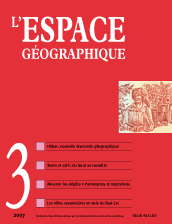

Coffee cultivation on the Boloven Plateau: regional integration versus territorial compartmentalisation (3 fig., 1 photo)
The Boloven Plateau in southern Laos forms part of the highlands of South-East Asia and is traditionally divided into two parts: on the western side, small coffee plantations inhabited by multi-ethnic groups, and on the eastern side, the Nya Heun, a marginalised, isolated forest people. From the mid 1990’s onwards, economic liberalization on the Boloven Plateau triggered a natural resources rush, boosting coffee cultivation, hydroelectric plants and deforestation. The resettlement of indigenous people and Boloven’s increasing integration into the peninsula’s economic networks are the major changes analysed in this paper.
keywords: BOLOVEN PLATEAU, COFFEE CULTIVATION, INDIGENOUS PEOPLE, LAOS, REGIONAL INTEGRATION
Cities at the edge of metropolisation in South-East Asia
This research programme focuses on the impact of the globalisation of the urban economy and the regionalisation of the world system on secondary South-East Asian cities at the edge of metropolisation. These cities, whether regional capitals or small national capitals, belong to a second generation of Asian metropolises. This paper examines the hypothesis that a metropolisation process is also occurring in these cities with specific markers and vectors but that it is not only a “minor” metropolisation process, even though its chronology, nature and intensity differ from those found in the major Asian metropolises.
keywords: GLOBALISATION, METROPOLISATION, SECONDARY CITY, SOUTH-EAST ASIA
Sampling procedures for landscape evaluation: measuring storm damage to a forest. (5 fig., 5 tabl.)
To qualify and quantify landscapes, a ground survey must be conducted, i.e. information gathered. How should this be done? Should the method used be random or not? Is it worth stratifying? If so, should the sampling ratio vary? This paper will evaluate various inventory methods (reminder of objectives, need to assess the evaluators, etc.). Using two examples of evaluations of the damage to forest areas in France caused by the 1999 windstorms, it shows that a survey based on sampling theory can prove accurate and easy to implement.
keywords: FOREST, FRANCE, SAMPLE, STORM, SURVEY
Determining the geographical origin of migrants using surnames: the example of some French cities in the early 20th century (6 fig., 2 tabl.)
A Bayesian method is proposed to estimate the probability of the geographical origin of migrants in a given area, using surname frequencies and changes over time. This method is applied to infer the origin of migrants leaving rural or small districts to settle in large urban centres at the time of World War I. The diversity of the origins of these new urban dwellers is linked to the specific geographical and historical features of the cities receiving migrants.
keywords: BAYESIAN METHOD, FRANCE, MIGRATION, RURAL EXODUS, SURNAME
Tom Thumb and the Giant. Mauritius and Brazil in the world sugar trade (3 fig.)
It may seem ironic to compare the positions of Brazil and Mauritius in the world sugar trade, since the former is a towering giant whereas the latter is losing one of the bases of its economy. The two countries nevertheless have common features, in terms of history and the place of sugar in their economies. A comparison is also justified by globalisation. The ACP/EU Sugar Protocol, which protected the ACP countries from world competition, is being cut back even as the market is heading down. The impact of this reorganisation of the market is not only economic but also spatial, since territories are forced to reorganise in order to meet the new challenges.
keywords: BRAZIL, GLOBALISATION, MAURITIUS, SUGAR, TERRITORIAL REORGANISATION
Voyage à pseudopole
Book reviews
In this issue of l’Espace géographique, you will find critical reviews of the following books
REY V., SAINT-JULIEN T. (2005). Territoires d’Europe, la différence en partage. Lyon: ENS éditions, 336 p. (Ségolène Debarre, université Paris I)
GUERMOND Y. (dir.) (2005). Modélisations en géographie, déterminismes et complexité. Paris: Hermès-Lavoisier, 389 p. (Denise Pumain, université Paris I)
L’espace géographique 2/07![]()
![]() L’espace géographique 4/07
L’espace géographique 4/07
For subscribe or buy this issue: BELIN
![]() L’Espace géographique: contents
L’Espace géographique: contents
Last modified: September 29, 2007